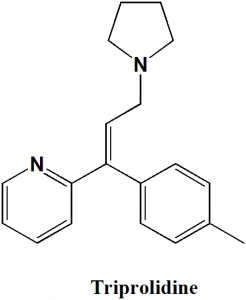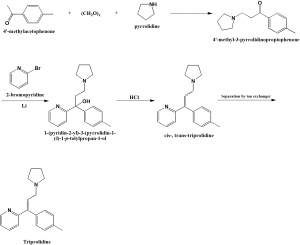TRIPROLIDINE Synthesis, SAR, MCQ,Structure,Chemical Properties and Therapeutic Uses
Triprolidine
IUPAC nomenclature
2-[(E)-1-(4-methylphenyl)-3-pyrrolidin-1-yl-prop-1-enyl]pyridine
Classification
- H1-receptor antihistamine
- Alkylamine antihistamine
Physiochemical Properties
| S. NO. | PHYSICAL AND CHEMICAL PROPERTIES | |
| 1 | Molecular weight | 278.4 g/mol |
| 2 | Physical appearance | Forms crystal from light petroleum |
| 3 | Melting point | 60oC |
| 4 | Solubility | 74.9 mg/LL |
| 5 | Octanol/water partition coefficient | 3.92 |
| 5 | Presence of ring | Phenyl, pyrrolidine |
| 6 | Number of chiral centers | Not present |
Mechanism of Action
i. Triprolidine binds to histamine H1 receptors and blocks the action of endogenous histamine.
ii. This provides relief from the negative symptoms produced by the histamine.
Structure Activity Relationship
Structure activity of alkyl amines antihistamines can be summarized as:
- E- and Z- isomers in alkenes shows large difference in activity, where, E-isomers are more potent than Z-
- The two aromatic rings have different binding environments at the receptors.
- 5-6 angstrom distance is required between aromatic ring and tertiary aliphatic amine for biding at the receptor.
- S-enantiomers have greater affinity for H1 histamine receptors [1]
Method of synthesis
i. 4’-methylacetophenone, paraformaldehyde and pyrrolidine are reacted together to give 4’-methyl-3-pyrrolidinopropiophenone.
ii. The above formed compound is reacted with lithium and 2-bromopyridine to give 1-(pyridin-2-yl)-3-(pyrrolidin-1-yl)-1-p-tolylpropan-1-ol
iii. Last compound is treated with hydrochloric acid to give a mixture of cis- and trans-triprolidine.
iv. Cis and trans- forms can be separated by using ion exchangers. [2]
Medicinal Uses
Triprolidine is used for treatment of:
- Allergies
- Hay fever
- Common cold
- Watery eyes
- Runny nose
- Sneezing
Side Effects
Side effects of triprolidine are:
- Seizures
- Loss of consciousness
- Hallucinations
- Drowsiness
- Dizziness
- Allergic reactions
- Confusion
- Nervousness
- Increased urination
- Blurred vision
- Dry mouth/throat/nose
- Restlessness
MCQs
Q.1 “2-[(E)-1-(4-methylphenyl)-3-pyrrolidin-1-yl-prop-1-enyl]pyridine” is the IUPAC nomenclature of which drug?
a) Brompheniramine
b) Clemastine
c) Triprolidine
d) Tenoxicam
Q.2 Molecular weight of Triprolidine is?
a) 144.5 gm/mol
b) 278.4 gm/mo
c) 290.79 gm/mol
d) 134.32 gm/mol
Q.3 Match the following with correct classifications of the drugs.
| i. Triprolidine | A. Alkylamine antihistamine drug |
| ii. Verapamil | B. H2-antagonist |
| iii. Ranitidine | C. Calcium channel blocker |
| iv. Mercaptopurine | D. Antimetabolite antineoplastic agent |
a. i-A, ii-C, iii-B, iv-D
b. i-C, ii-D, iii-A, iv-B
c. i-D, ii-,B iii-A, iv-C
d. i-A, ii-D, iii-C, iv-B
Q.4 Which of the following mechanisms are involved for the action of Triprolidine drug?
I. Produces antagonistic effects on Nicotinic receptors
II. Produces antagonistic effects on H1 receptors
III. There is blockage of action of endogenous histamine
IV. It also alkylates the genetic material of cell causing death of neoplastic cells.
a) I, IV
b) II, III
c) I, III, IV
d) I, II, III
Q.5 Correct sequence for True and False for the given statements related with the SAR of class alkylamines antihistamines can be?
- E- and Z- isomers in alkenes shows large difference in activity, where, E-isomers are more potent than Z-
- The two aromatic rings have different binding environments at the receptors.
- 5-6 angstorm distance is required between aromatic ring and tertiary aliphatic amine for biding at the receptor.
- S-enantiomers have greater affinity for H1 histamine receptors.
a) TFFT
b) TFTF
c) TTTT
d) FTFF
Q.6 The cis- and trans- forms of triprolidine can be separated using?
a) Ion exchanger
b) Free radicals
c) Hydrogen gas
d) None of the above
Q.7 The drug Triprolidine is mainly used for?
a) Treatment of sneezing
b) Treatment of watery eyes
c) Treatment of runny nose
d) All of the above
Participate in Online FREE GPAT TEST: CLICK HERE
Participate in Online FREE Pharmacist TEST: CLICK HERE
Participate in Online FREE Drug Inspector TEST: CLICK HERE
ANSWERS
1-c
2-b
3-a
4-b
5-c
6-a
7-d
REFERENCES
[1] Lemke TL, Williams DA, editors. Foye’s principles of medicinal chemistry. Lippincott Williams & Wilkins; 2012 Jan 24. [2] US 2 712 020 (Burroughs Wellcome; 1955; GB-prior. 1948).

